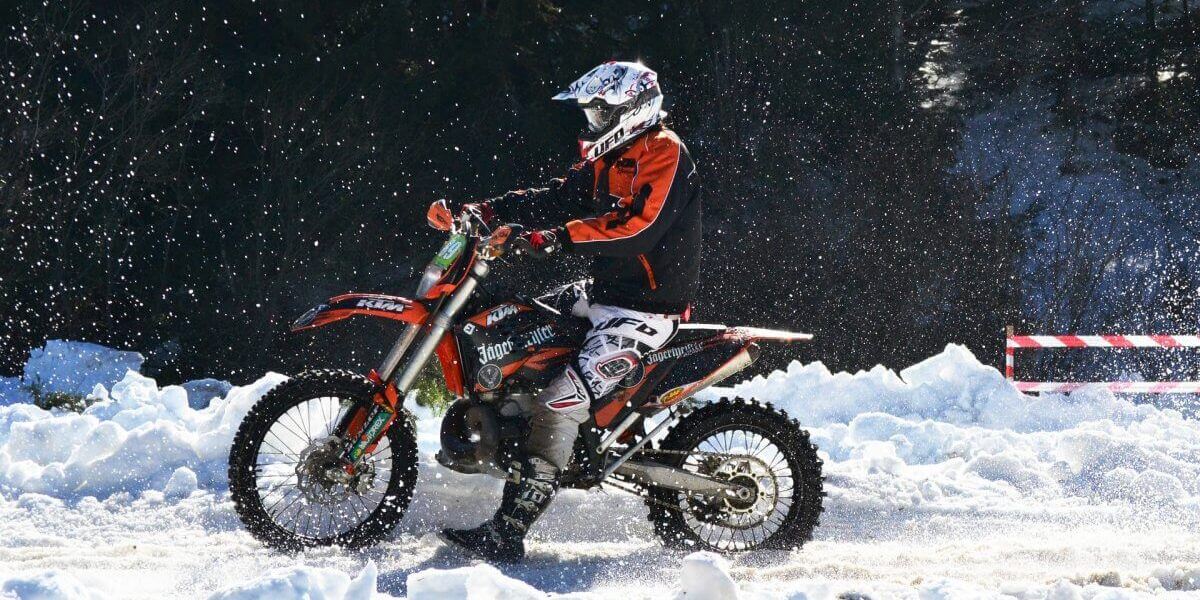
Winter can bring a unique and exciting challenge to dirt biking. While many riders might store their bikes during the cold months, those who take on the cold know it’s a whole different adventure. But, to make it safe and keep your bike in one piece, a bit of extra prep goes a long way.
If you’re new to dirt biking or just want to keep riding through winter, preparing both yourself and your bike for the cold is crucial. Winter riding comes with requirements—extra bike maintenance, special gear, and careful preparation. Skipping these steps can lead to a tough ride, or even worse, problems with your bike.
This guide will cover everything you need to know to get your dirt bike winter-ready. From essential maintenance checks to a few cold-weather tweaks, you’ll be geared up for winter dirt biking, confident that your bike’s set to handle whatever the season throws at you.
Comprehensive Winter Maintenance Checklist for Your Dirt Bike
Needless to say, winter riding takes a toll on your dirt bike, so it’s worth taking a few extra steps to keep everything in top shape. Here’s how to keep your bike prepped and ready for each cold-weather ride.
Battery Care and Electrical Health
Winter drains batteries fast, which can make starting your bike a struggle. A trickle charger is a useful tool to keep the battery topped off without overcharging—especially handy if you’re not riding every day. When using a trickle charger, make sure not to leave it connected for days at a time; overcharging can damage the battery, especially in cold weather. Charge it fully, then disconnect and check the voltage every week or so. Regularly inspect the battery terminals for any rust or corrosion that might interfere with power flow, and clean them as needed.
For extra protection, apply dielectric grease to exposed electrical parts, which helps keep snow and moisture from causing shorts. If you plan to store the bike for a while, consider removing the battery and storing it in a warmer area to help maintain its charge.
Cold-Weather Lubrication and Fluids
Cold temperatures can make standard oils and fluids less effective, so winter-grade options are your best bet. Switch to a winter-grade engine oil to keep parts moving smoothly, even in the cold. If you're new to winter oil, look for a 5W or 0W rating; these flow better at low temps, reducing wear on startup. Make sure your coolant is rated for freezing temperatures, and top it off as needed. Also, double-check that your radiator cap seals tight—a loose cap can let cold air in, dropping coolant pressure and causing performance issues.
Moreover, rubber components, like hoses, pivot points, and cables, also take a beating in the cold, becoming brittle over time. Check hoses for any cracks, and apply a winter-grade lubricant to pivot points and cables to keep them moving freely.
Suspension Maintenance and Adjustments
Cold weather can make your suspension feel stiff and less responsive. We often see winter riders come in with suspension issues because their fluid thickened up in the cold, making handling a lot rougher. To avoid this, top off with a winter-grade fluid (like 2.5W or 5W), which stays more responsive in low temps.
Also, take a moment to inspect around the seals for any leaks—this is especially important in winter since any existing leaks can worsen with temperature fluctuations.
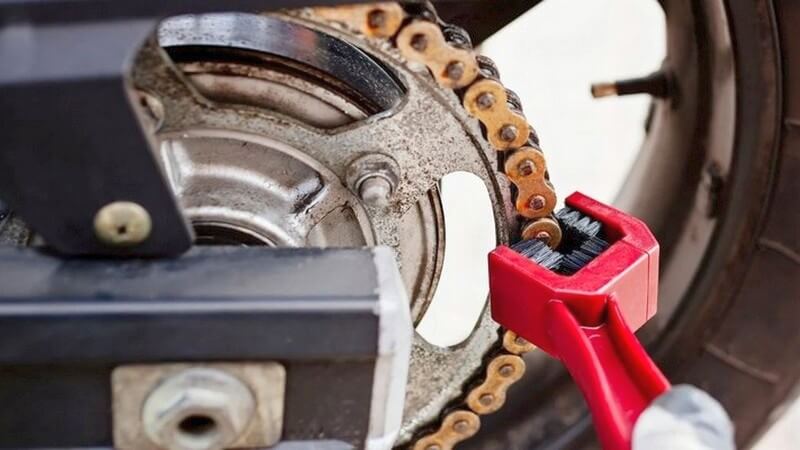

Chain and Sprocket Care
Cold and snow can dry out chains, leading to rust and premature wear. We get a lot of bikes in the shop with rusted chains simply because riders didn’t reapply lube after a snowy ride. Take the time to clean and apply a winter-grade chain lube—look for one with a bit of wax, which helps it stick through snowy conditions. Just make sure to let it dry before you head out, so it doesn’t fling off on the trail.
Also, check the chain’s tension and look for any signs of wear. A loose or worn chain is more likely to slip or snap in tough winter conditions, so keeping it in good shape will help ensure smooth rides.
Exhaust System Maintenance
Cold weather and moisture can quickly lead to rust and blockages in the exhaust, which impact performance. Consider applying a high-temp anti-rust spray to the exhaust—this is an easy way to protect it from moisture damage. Just make sure the exhaust is clean and dry before applying, and give it a quick wipe down after each ride to keep rust at bay.
Brake System Preparation
Brakes work hard in winter, so regular checks are essential. Inspect the brake pads—winter riding can wear them down faster, so replace them if they’re getting thin. One trick for winter is to switch to sintered brake pads if you haven’t already; they handle cold and moisture better than organic pads, so you’ll have more reliable braking in icy conditions.
Switching to a winter-grade brake fluid can make braking more reliable in the cold, as it’s designed to withstand lower temperatures. Finally, inspect the brake lines, as cold can make rubber lines brittle and prone to cracking. And if you’re out on salted roads, rinse the brake calipers after every ride to prevent corrosion.
Fuel System Winterization
Condensation in the fuel tank can freeze and clog the system, causing issues. If you’re not planning to drain the tank, be sure to add a fuel stabilizer—trust me, a gummed-up fuel system is one of the top reasons bikes end up back in the shop for costly repairs. After adding the stabilizer, run the engine for a few minutes to circulate it through the system, ensuring every part is protected, not just the tank.
All in all, regular checks and a bit of extra care will keep your bike ready for whatever winter throws at you. Take the time to do it right, and you’ll keep riding smoothly all season long.
Essential Modifications to Prepare Your Bike for Winter Conditions
A few smart tweaks can make a big difference in how your dirt bike handles winter’s snow, ice, and freezing temps. These modifications will boost traction, keep you in control, and protect critical parts from the cold.
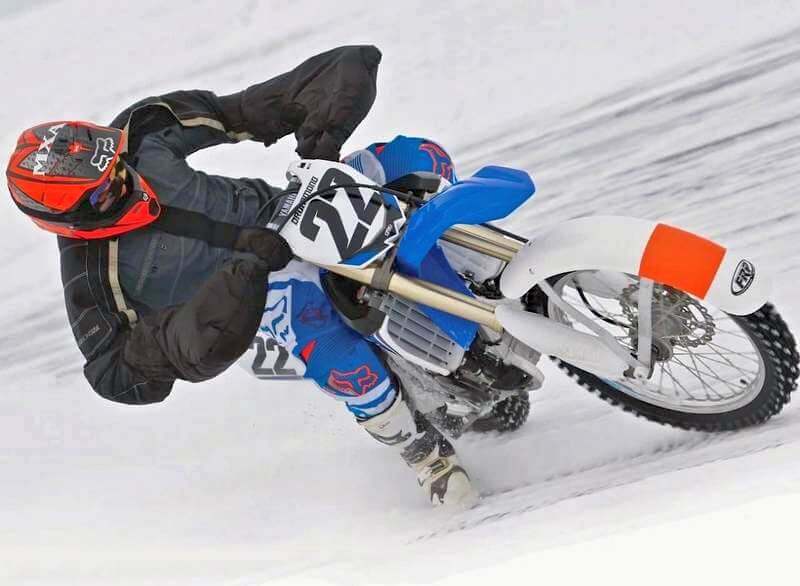

Snow and Ice Tires
When it comes to winter riding, the right tires are essential to stay upright and moving forward. Consider the following:
- Spiked or Studded Tires: The best winter tires have spikes or studs for extra grip on snow and ice. Brands like Trelleborg and Michelin make high-quality spiked tires—while they’re an investment (around $550 a set), they’ll give you reliable traction for multiple seasons if you take care of them.
- DIY Screw Traction: If spiked tires aren’t in the budget, you can add screws to your current tires. Kold Kutter makes screws designed for motorcycle tires that offer solid grip. Choose screws around half an inch long for the rear tire but be cautious not to puncture the inner tire casing.
- Choose Based on Snow Depth: Spiked tires work best on hard-packed snow and ice, while softer tires with screws perform better in moderate, fluffy snow. Aim for snow less than 8-9 inches deep for the best control.
Grip Heaters and Handguards
Cold hands mean reduced control, so adding grip heaters and handguards can significantly improve your winter riding experience. Grip heaters, electric heating elements that fit under the handlebars, offer direct warmth to your hands and often include adjustable high/low settings. Just check that your bike’s electrical system can support them.
In addition to heaters, handguards and bar muffs help block out the wind, snow, and debris. While bar muffs may look bulky, they provide added protection by covering both your grips and hands, keeping the cold air off during longer rides.
Carburetor and Air Intake Protection
In winter, snow can easily get into critical areas like the carburetor and air intake, freezing up parts and impacting performance. Installing a simple carburetor protector—like a piece of rubber or plastic secured with zip ties—can block snow from reaching this sensitive area. Without this shield, you might find snow freezing inside, causing the engine to sputter or lose power.
Similarly, an air intake cover or mesh barrier helps keep snow thrown up by the rear wheel from clogging the intake, maintaining proper airflow to the engine.
Chain Guard and Skid Plate
Snow and ice bring a lot of extra debris along for the ride, so adding guards to the chain and underside of your bike will keep things moving smoothly. A full chain guard prevents ice and snow from sticking to the chain, preserving lubrication and reducing wear over time.
If your bike doesn’t already have one, a skid plate is worth adding for winter. It protects the underside from rocks, ice, and hidden debris while also reducing snow buildup under the engine. This small addition keeps the bike lighter by preventing snow from weighing it down, giving you better ground clearance.
Making these modifications will set your dirt bike up to handle winter’s unique demands, so you can hit the trails no matter how cold or snowy it gets.
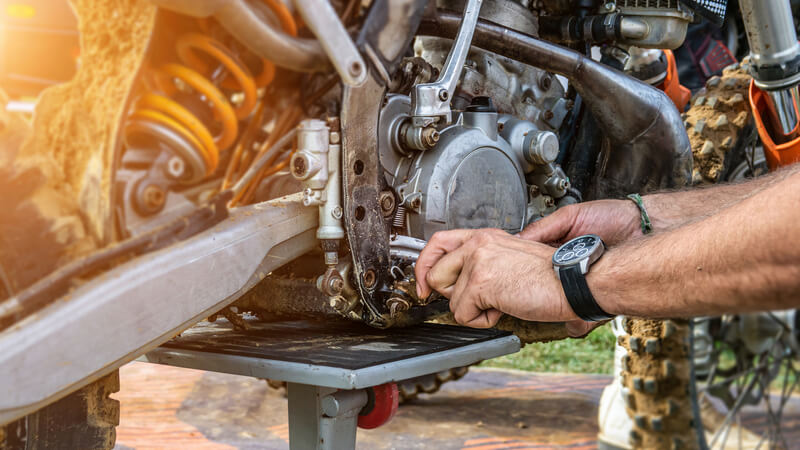

Pre-Ride Preparation and Winter Riding Tips
To get the most out of winter dirt biking, you’ll need a solid prep routine. From startup tips to route planning and gear selection, here’s what to know before you hit those cold trails.
Cold-Weather Startup and Warmup Tips
Starting your bike in freezing temps needs a little extra attention, such as:
- Check Battery Charge: Cold drains battery power fast, so make sure it’s fully charged before you set out. A trickle charger helps keep it topped up when parked.
- Prime the Carburetor: If your bike’s carbureted, engage the choke to enrich the fuel mix, which makes starting easier in the cold.
- Let It Idle: Give the bike 3-5 minutes to idle before hitting the throttle. This helps circulate oil and cuts down on engine wear.
- Listen for Odd Sounds: While warming up, listen for anything unusual, as it could mean a part isn’t fully lubricated yet.
Planning Your Route
Winter riding conditions can change rapidly, so knowing your route is essential. Stick to familiar trails if possible, as snow and ice can hide rocks, roots, and other obstacles you’d easily spot in summer. With shorter winter days, plan to wrap up before dark and check the weather forecast to avoid sudden snow or icy conditions. If you’re heading out alone, consider using GPS or a tracking app and share your route with a friend as a precaution.
Choosing the Right Gear
Staying warm and comfortable is all about layering up with the right gear. Start with a moisture-wicking base layer to keep sweat off your skin, add an insulated mid-layer for warmth, and top it with a waterproof, windproof shell to block the elements. A full-face helmet with anti-fog goggles is ideal for winter rides, and adding a skull cap or thermal liner inside the helmet offers extra warmth.
As for gloves, winter-specific ones with thin, insulated palms allow better grip and heated grips are a solid upgrade. On your feet, go for waterproof boots layered with moisture-wicking socks—this setup will help you stay dry and warm throughout the ride.
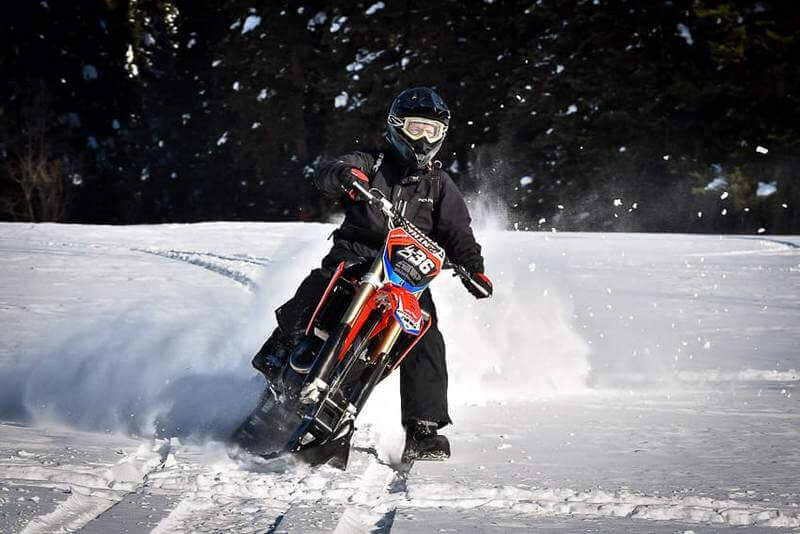

Essential Accessories for Winter Dirt Biking
A few extras can make all the difference when you’re out in the cold. It’s best to have these things with you:
- Portable Power Bank: Cold zaps battery life fast, so a power bank is handy to recharge your phone or GPS on the go.
- Hydration Pack: It’s easy to forget to drink in the cold, but a hydration pack keeps water accessible. Look for an insulated one to prevent freezing.
- Compact Tool Kit and First Aid Kit: Always pack a small tool kit for quick fixes and basic first aid supplies for minor injuries.
✱ Pro tip: Winter rides can be unpredictable, so bring along a few extra zip ties in your pack. They’re handy for quick fixes if something rattles loose or if snow buildup starts to interfere with the chain or cables. A little prep goes a long way when you’re out in the cold and far from the garage!
Frequently Asked Questions (FAQs)
How do I prepare my dirt bike for riding in the snow?
To get your dirt bike ready for snow, consider installing studded tires or adding ice screws for better grip on icy trails. Protect the carburetor from freezing by covering it, and make sure your coolant is rated for low temps. Check the airbox regularly to keep snow from blocking the filter.
What gear should I wear for winter dirt biking?
Wear thermal base layers to stay warm, topped with a waterproof, windproof jacket. Insulated gloves, waterproof boots, and a balaclava or neck warmer will help fight off the chill. Handguards or bar muffs can also keep your hands warm by blocking cold air.
Can I ride a dirt bike in deep snow?
Riding in deep snow is tough. Most dirt bikes can handle 3-4 inches of snow with stock tires. For deeper snow, you’ll need modifications like studded tires or a snow bike kit. Always check snow depth and consistency before heading out.
How should I adjust my riding technique for winter conditions?
In winter, slow down and keep a relaxed grip, as traction is reduced. Use smooth throttle and braking to avoid skidding, and shift your weight for balance, especially on icy or snowy trails.
What maintenance is needed after winter rides?
After riding, clean your bike thoroughly to remove salt and moisture that can lead to rust. Lubricate the chain, cables, and pivot points. Check for any tire or component damage, and make sure the air filter is dry and clean.
What are some good dirt bikes for snow riding?
For snow, look for bikes with solid torque and handling. The Yamaha YZ450FX, KTM 300 XC-W, and Honda CRF450RX are popular picks that handle snow-covered terrain well.
Take on Winter Trails Like a Pro
Indeed, winter dirt biking isn’t for everyone, but for those who take it on, the reward is an experience unlike any other season offers. The cold tests both you and your bike, but with the right prep and mindset, you’ll find that winter trails can be some of the most memorable ones you’ll ride. So layer up, check your bike, and embrace the adventure that winter brings.
If you’re geared up and prepared, winter dirt biking will be the season’s ultimate test of skill and grit. See you on the trails, and remember, it’s all about keeping that bike—and yourself—firing on all cylinders.
